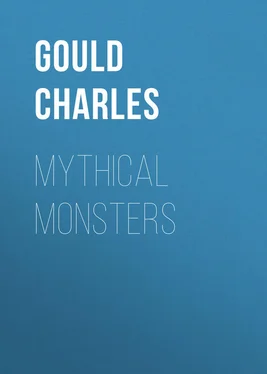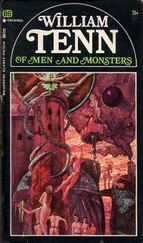Charles Gould - Mythical Monsters
Здесь есть возможность читать онлайн «Charles Gould - Mythical Monsters» — ознакомительный отрывок электронной книги совершенно бесплатно, а после прочтения отрывка купить полную версию. В некоторых случаях можно слушать аудио, скачать через торрент в формате fb2 и присутствует краткое содержание. Жанр: Мифы. Легенды. Эпос, Природа и животные, foreign_antique, foreign_prose, на английском языке. Описание произведения, (предисловие) а так же отзывы посетителей доступны на портале библиотеки ЛибКат.
- Название:Mythical Monsters
- Автор:
- Жанр:
- Год:неизвестен
- ISBN:нет данных
- Рейтинг книги:5 / 5. Голосов: 1
-
Избранное:Добавить в избранное
- Отзывы:
-
Ваша оценка:
- 100
- 1
- 2
- 3
- 4
- 5
Mythical Monsters: краткое содержание, описание и аннотация
Предлагаем к чтению аннотацию, описание, краткое содержание или предисловие (зависит от того, что написал сам автор книги «Mythical Monsters»). Если вы не нашли необходимую информацию о книге — напишите в комментариях, мы постараемся отыскать её.
Mythical Monsters — читать онлайн ознакомительный отрывок
Ниже представлен текст книги, разбитый по страницам. Система сохранения места последней прочитанной страницы, позволяет с удобством читать онлайн бесплатно книгу «Mythical Monsters», без необходимости каждый раз заново искать на чём Вы остановились. Поставьте закладку, и сможете в любой момент перейти на страницу, на которой закончили чтение.
Интервал:
Закладка:
It seems probable that discoveries of mammoth tusks formed in part the basis for the story which Pliny tells in reference to fossil ivory. He says 43: – “These animals [elephants] are well aware that the only spoil that we are anxious to procure of them is the part which forms their weapon of defence, by Juba called their horns, but by Herodotus, a much older writer, as well as by general usage, and more appropriately, their teeth. Hence it is that, when these tusks have fallen off, either from accident or old age, they bury them in the earth.”
Nordenskjöld 44states that the savages with whom he came in contact frequently offered to him very fine mammoth tusks, and tools made of mammoth ivory. He computes that since the conquest of Siberia, useful tusks from more than twenty thousand animals have been collected.
Mr. Boyd Dawkins, 45in a very exhaustive memoir on this animal, quotes an interesting notice of its fossil ivory having been brought for sale to Khiva. He derives 46this account from an Arabian traveller, Abou-el-Cassim, who lived in the middle of the tenth century.
Figuier 47says: “New Siberia and the Isle of Lachon are for the most part only an agglomeration of sand, of ice, and of elephants’ teeth. At every tempest the sea casts ashore new quantities of mammoth’s tusks, and the inhabitants of New Siberia carry on a profitable commerce in this fossil ivory. Every year during the summer innumerable fishermen’s barks direct their course to this isle of bones, and during winter immense caravans take the same route, all the convoys drawn by dogs, returning charged with the tusks of the mammoth, weighing each from one hundred and fifty to two hundred pounds. The fossil ivory thus withdrawn from the frozen north is imported into China and Europe.”
In addition to its elimination by the thawing of the frozen grounds of the north, remains of the mammoth are procured from bogs, alluvial deposits, and from the destruction of submarine beds. 48They are also found in cave deposits, associated with the remains of other mammals, and with flint implements. This creature appears to have been an object of the chase with Palæolithic man.
Mr. Dawkins, reviewing all the discoveries, considers that its range, at various periods, extended over the whole of Northern Europe, and as far south as Spain; over Northern Asia, and North America down to the Isthmus of Darien. Dr. Falconer believes it to have had an elastic constitution, which enabled it to adapt itself to great change of climate.
Murchison, De Verneuil, and Keyserling believed that this species, as well as the woolly rhinoceros, belonged to the Tertiary fauna of Northern Asia, though not appearing until the Quaternary period in Europe.
Mr. Dawkins shows it to have been pre-glacial, glacial, and post-glacial in Britain and in Europe, and, from its relation to the intermediate species Elephas armeniacus , accepts it as the ancestor of the existing Indian elephant. Its disappearance was rapid, but not in the opinion of most geologists cataclysmic, as suggested by Mr. Howorth.
Another widely distributed species was the Rhinoceros tichorhinus – the smooth-skinned rhinoceros – also called the woolly rhinoceros and the Siberian rhinoceros, which had two horns, and, like the mammoth, was covered with woolly hair. It attained a great size; a specimen, the carcase of which was found by Pallas imbedded in frozen soil near Wilui, in Siberia (1772), was eleven and a half feet in length. Its horns are considered by some of the native tribes of northern Asia to have been the talons of gigantic birds; and Ermann and Middendorf suppose that their discovery may have originated the accounts by Herodotus of the gold-bearing griffons and the arimaspi.
Its food, ascertained by Von Brandt, and others, from portions remaining in the hollows of its teeth, consisted of leaves and needles of trees still existing in Siberia. The range of this species northwards was as extensive as that of the mammoth, but its remains have not yet been discovered south of the Alps and Pyrenees.
The investigation, 49made by M. E. Lartet in 1860, of the contents of the Grotto of Aurignac, in the department of the Haute Garonne, from which numerous human skeletons had been previously removed in 1852, shows that this animal was included among the species used as ordinary articles of food, or as exceptional items at the funeral feasts of the Palæolithic troglodytes. In the layers of charcoal and ashes immediately outside the entrance to the grotto, and surrounding what is supposed to have been the hearth, the bones of a young Rhinoceros tichorhinus were found, which had been split open for the extraction of the marrow. Numerous other species had been dealt with in the same manner; and all these having received this treatment, and showing marks of the action of fire, had evidently been carried to the cave for banqueting purposes. The remains of Herbivora associated with those of this rhinoceros, consisted of bones of the mammoth, the horse ( Equus caballus ), stag ( Cervus elaphus ), elk ( Megaceros hibernicus ), roebuck ( C. capreolus ), reindeer ( C. tarandus ), auroch ( Bison europæus ). Among carnivora were found remains of Ursus spelæus (cave-bear), Ursus arctos ? (brown bear), Meles taxus (badger), Putorius vulgaris (polecat), Hyæna spelæa (cave-hyæna), Felis spelæa (cave-lion), Felis catus ferus (wild cat), Canis lupus (wolf), Canis vulpis (fox). Within the grotto were also found remains of Felis spelæa (cave-lion) and Sus scrofa (pig). The cave-bear, the fox, and indeed most of these, probably also formed articles of diet, but the hyæna seems to have been a post attendant at the feast, and to have rooted out and gnawed off the spongy parts of the thrown-away bones after the departure of the company.
In the Pleistocene deposits at Würzburg, in Franconia, a human finger-bone occurs with bones of this species, and also of other large mammalia, such as the mammoth, cave-bear, and the like.
And flint implements, and pointed javelin-heads made of reindeer horn, are found associated with it in the vicinity of the old hearths established by Palæolithic man in the cave called the Trou du Sureau, on the river Malignée in Belgium.
In the cavern of Goyet, also in Belgium, there are five bone layers, alternating with six beds of alluvial deposits, showing that the cave had been inhabited by different species at various periods. The lion was succeeded by the cave-bear, and this by hyænas; then Palæolithic man became a tenant and has left his bones there, together with flint implements and remains of numerous species, including those already enumerated as his contemporaries.
The Sabre-toothed Tiger or Lion. – This species, Machairodus 50 latifrons of Owen, was remarkable for having long sabre-shaped canines. It belongs to an extinct genus, of which four other species are known, characterised by the possession of serrated teeth. The genus is known to be represented in the Auvergne beds between the Eocene and Miocene, in the Miocene of Greece and India, in the Pliocene of South America and Europe, and in the Pleistocene. Mr. Dawkins believes that this species survived to post-glacial times. It is one of the numerous animals whose remains have been found with traces of man and flint implements in cave deposits at Kent’s Hole, near Torquay, and elsewhere.
The Cave-Bear, Ursus spelæus , of Rosenmüller. – The appearance of this species has been preserved to us in the drawing by Palæolithic man found in the cave of Massat (Arieze).
It occurs in the Cromer Forest Bed, a deposit referred by Mr. Boyd Dawkins to the early part of the Glacial period, and generally regarded as transitional between the Pliocene and Quaternary. It is also found in the caves of Perigaud, which are considered to belong to the reindeer era of M. Lartet or the opening part of the Recent period, and numerous discoveries of its remains at dates intermediate to these have been made in Britain and in Europe. Carl Vogt, indeed, is of opinion that this species is the progenitor of our living brown bear, Ursus arctos , and Mr. Boyd Dawkins also says that those “who have compared the French, German, and British specimens, gradually realize the fact that the fossil remains of the bears form a graduated series, in which all the variations that at first sight appear specific vanish away.”
Читать дальшеИнтервал:
Закладка:
Похожие книги на «Mythical Monsters»
Представляем Вашему вниманию похожие книги на «Mythical Monsters» списком для выбора. Мы отобрали схожую по названию и смыслу литературу в надежде предоставить читателям больше вариантов отыскать новые, интересные, ещё непрочитанные произведения.
Обсуждение, отзывы о книге «Mythical Monsters» и просто собственные мнения читателей. Оставьте ваши комментарии, напишите, что Вы думаете о произведении, его смысле или главных героях. Укажите что конкретно понравилось, а что нет, и почему Вы так считаете.











